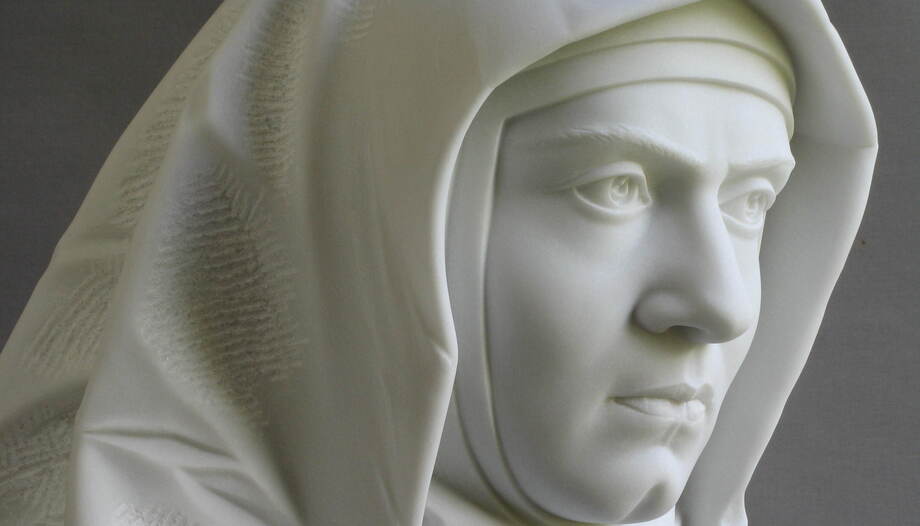- Colleen Pressprich, OSV News
The Doctors of the Church are the saints many of us need to better understand the faith and, more than that, to grow in our relationship with the Lord. Among the 37 great saints are four women doctors of the Church: saint Hildegard of Bingen (German); saint Catherine of Siena (Italian); saint Teresa of Avila (Spanish), and saint Therese of Lisieux (French).
As will be seen at the end, quite a few Catholics consider that there are at least three other women saints who should be doctors of the Church: St. Faustina Kowalska, Polish; St. Edith Stein, German-Polish; and St. Marguerite Marie Alacoque, French.
Find a pattern, or many
As Catholics, we are incredibly blessed to have the communion of saints, and the Church encourages each and every one of us to find a patron (or many) among them.
To facilitate the search for a saint that fits particular needs, the Church has designated saints as patrons of countries, cultures, professions, interests and even illnesses. Among women are, for the moment, the four mentioned above.
St. Hildegard of Bingen
It is not possible to give a complete account of their lives in a single article. Each of them has been the subject of countless biographies and much research. But I hope that a brief sketch of their lives and accomplishments will encourage you to read one of those biographies or, better yet, their writings.
St. Hildegard of Bingen was born into a noble German family in 1098. Already as a child she had mystical visions of the Lord, although it was not until a later age that she was able to understand the meaning of all of them. As a young woman, she entered religious life, and it was there that she really exploited her talents. St. Hildegard was a woman who did everything and did it well.
Authorized to preach publicly
At the age of 43, she asked her spiritual director for advice about her visions, and their authenticity was declared by a committee of ecclesiastical theologians. This led her to write down her visions and meanings in her great mystical work: 'The Scivias'. It also allowed her to request and receive permission from the Pope to travel and evangelize, making her one of the only women of her time authorized to preach publicly. An enduring theme in St. Hildegard's theology is the ability to encounter God through the use of our senses.
In addition, the prolific Hildegard wrote the first known work on morality, lyrical poetry, a cookbook, medical treatises (in her time she was also the equivalent of a physician) and even invented her own language. She also composed music of great beauty, which is still performed today by orchestras all over the world.
St. Hildegard died in 1179. She was canonized in 2012 by Pope Benedict XVI and declared a Doctor of the Church that same year.
St. Catherine of Siena
St. Catherine of Siena was born in 1347 into a highly respected Italian family. She was the youngest of 25 siblings, most of whom did not reach adulthood. Catherine consecrated herself to Christ as a young woman and refused to marry, even going so far as to cut her hair to stop a marriage proposal.
She reluctantly obtained her parents' permission to renew her vow of virginity and enter the third order of the DominicansThis would allow him to continue living with his family.
For many years, St. Catherine lived as a hermit in her family's home, but eventually she began to venture out, and her ministry spread across oceans. She traveled widely at the behest of both popes and civil leaders, playing an active role in the Church and in Italian politics, both of which were very complicated during her lifetime.
End of the Papacy of Avignon and return to Rome
St. Catherine was lucid about the sins and failures of the Church leaders, but obedience to the Lord and the Church were most important to her. She always strove to draw more and more people to Christ, her husband, while working for peace between the warring parties. In fact, St. Catherine is credited with bringing about the end of the Avignon papacy and the Pope's return to Rome.
She wrote a great deal, mostly in the form of letters, in which she offered frank but loving advice to her spiritual children, as well as to the bishops and cardinals who came to her for wisdom. Nearly 400 of her letters are preserved today.
Deep prayer, and stigmata of the Lord
In a state of ecstasy, St. Catherine dictated a series of conversations she had with the Lord, which were later published under the title 'The Dialogue'. This work, intimately personal and full of teachings applicable to all, perfectly intertwines theology and personal prayer.
St. Catherine's prayer life was deep and full of mysticism, and she received the stigmata of the Lord at the age of 28. She died young, only 33 years old. She was canonized in 1461.
Saint Teresa of Avila
The woman we know today as St. Theresa de Ávila was born Teresa Sánchez de Cepeda y Ahumada on March 28, 1515. Born into a family of Spanish nobility, Teresa learned about faith and honor on her mother's lap. The lives of the saints, read to all the children in the family, influenced her childhood, to the point that she and her brother Rodrigo ran away from home, vowing to become martyrs.
At the age of 20, Teresa entered the local Carmelite convent. This particular convent was known for being lax in its practices, and as a result, the outgoing and popular Teresa spent much of her time socializing in the parlor with visitors. In fact, for years she struggled greatly, torn between the mundane and the divine.
Foundation of the Discalced Carmelite Nuns
It was not until the age of 40 that she had a total conversion and the conviction that God was asking more of her. It was this deep spiritual awakening within her that began what would end up being the great restoration of the Carmelite order as a whole and the founding of the Discalced Carmelites.
Teresa's attempts to restore the Order to its original austerity were met with great resistance both within and without, but she still managed to found and nurture 16 new convents.
In addition to this great work, Teresa wrote a great deal, especially to the sisters with whom she lived and whom she counseled, to help them achieve greater intimacy with God. Her best known work is 'The Interior Castle', which follows the journey of a soul on its way to Christ.
Although it deals extensively with great theological truths, it is also very easy to read for the average person, and contains much of the author's personality, which makes it very accessible and interesting. Teresa of Avila died at the age of 67, in 1582. She was canonized 40 years after her death, in 1622, by Pope Gregory XV.
Saint Therese of Lisieux
St. Therese of Lisieux was born the youngest of nine children (five survived infancy) of Saints Louis and Zelie (Celia) Martin and was, by all accounts, a beloved member of her family. After the death of her mother when she was 4 years old, Therese was raised by her father and older sisters.
She knew that God was calling her to religious life at a very young age and was determined to follow several of her older sisters and enter the Carmelite order. During a papal audience while on a pilgrimage to Rome with her father, she asked the Pope to grant her special permission to profess her vows early. Undeterred by his refusal, she entered Carmel at the tender age of 15 and never looked back.
Story of a Soul
Teresa struggled with scrupulosity and depression, but nevertheless maintained a deep, childhood faith in the Father's love for her that would become the cornerstone of her great theological work. Under the orders of her superior, Teresa wrote his doctrine of faith: 'History of a soul'.
This book, which preaches holiness through the ordinary combined with a fearless faith that is total in trust and surrender to God, would later lead her to become the youngest of all doctors of the Church. Teresa died of tuberculosis at the tender age of 24. She was canonized in 1925.
They deserve to be doctors: St. Faustina Kowalska
In my humble opinion, there are certainly other women who deserve to be awarded this title. And I am not the only one who thinks so.
In 2015, the Marian Auxiliatrixes drafted a well-reasoned and thoroughly researched petition to the Holy See, arguing that. Saint Faustina Kowalska should be admitted to the group.
Through his visions and writings, the Church has come to a deeper understanding of Christ's merciful love, and his insights into the Divine Mercy of Our Lord have changed the face of the Church.
Writing just before the outbreak of World War II, it is undeniable that St. Faustina's message was urgent in her time, and no one who attended Mass on the Sunday after Easter, now known throughout the world as Divine Mercy Sunday, can dispute the worldwide and enduring nature of her message.
Saint Edith Stein
The Carmelite nuns have also initiated a petition on behalf of Saint Edith Steina woman who actually had a doctorate degree.
His doctoral thesis was on the subject of empathy, a theme that he would return to in later writings after his conversion to Catholicism. In his 28 volumes of writings, there is a broad theological vision of value to the whole Church.
Saint Margaret Mary Alacoque
And who would argue that the writings of Saint Margaret Mary of Alacoque have they not influenced the whole Church? His name may be less familiar to many than that of other saints, but the devotion to the Sacred Heart, which we owe to him, is not.
These are just three examples. There are more women in the history of our Church and, I am sure, there will be more women doctors of the Church in the future.
—————————
This article is a translation of an article first published in OSV News. You can find the original article here.
--------









